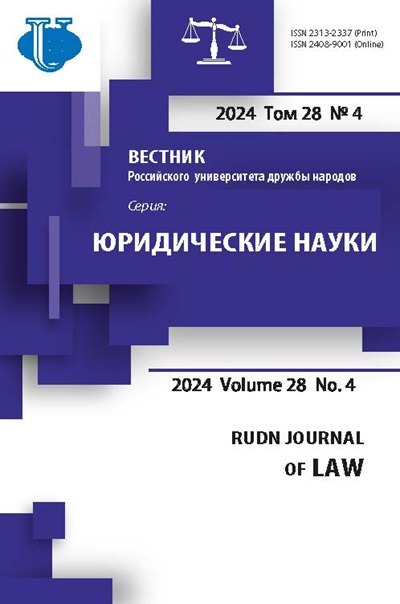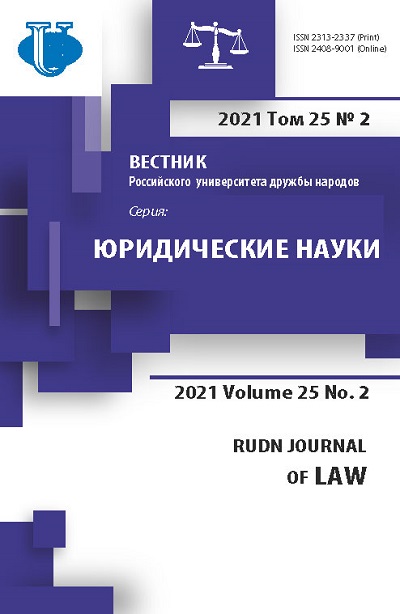Международные правовые проблемы реализации концепции управления космическим движением
- Авторы: Абашидзе А.Х.1, Солнцев А.М.1, Мирзаи С.2, Даварзани М.3
-
Учреждения:
- Российский университет дружбы народов
- Исламский университет Азад
- Университет Шахида Бехешти
- Выпуск: Том 25, № 2 (2021)
- Страницы: 700-713
- Раздел: МЕЖДУНАРОДНОЕ ПРАВО. ЗАРУБЕЖНОЕ ПРАВО
- URL: https://journals.rudn.ru/law/article/view/26721
- DOI: https://doi.org/10.22363/2313-2337-2021-25-2-700-713
Цитировать
Полный текст
Аннотация
Детально анализируется концепция управления космическим движением, которая в последние три десятилетия вызвала большой интерес у всех государств и иных участников, вовлеченных в космическую деятельность. С наступлением «новой космической эры» («NewSpace», или «космос 2.0») и ростом экономических стимулов для космической деятельности эта тема привлекла много внимания общественности и стала важным пунктом повестки дня Юридического подкомитета Комитета Организации Объединенных Наций по использованию космического пространства в мирных целях. Однако разработка и внедрение международных правил космического движения является сложной задачей, особенно для новых частных участников космической деятельности. Эта статья призвана оценить существующие международно-правовые проблемы реализации концепции управления космическим движением и предложить некоторые решения для их преодоления. В рамках настоящей статьи, во-первых, будет оценена и обсуждена необходимость установления регулирования управления космическим движением, а также перечислены требования, которые необходимо решить для достижения этой цели. Во-вторых, будут проанализированы определения, предоставленные государственными и негосударственными организациями в отношении этой концепции, и меры, принятые для ее реализации. В конечном итоге будут обсуждены теоретические и практические международно-правовые проблемы, с которыми сталкиваются участники космической деятельности при реализации этой концепции. В заключение подчеркивается важность поощрения усилий и координации между всеми действующими и потенциальными участниками космической деятельности с должным учетом потребностей последних.
Об авторах
Аслан Хусейнович Абашидзе
Российский университет дружбы народов
Автор, ответственный за переписку.
Email: abashidze-akh@rudn.ru
ORCID iD: 0000-0003-0012-8795
доктор юридических наук, профессор, заведующий кафедрой международного права, Юридический институт
117198, Российская Федерация, г. Москва, ул. Миклухо-Маклая, д. 6Александр Михайлович Солнцев
Российский университет дружбы народов
Email: solntsev-am@rudn.ru
ORCID iD: 0000-0002-9804-8912
кандидат юридических наук, доцент кафедры международного права, Юридический институт
117198, Российская Федерация, г. Москва, ул. Миклухо-Маклая, д. 6Сиаваш Мирзаи
Исламский университет Азад
Email: siavash.mirzaei1988@gmail.com
ORCID iD: 0000-0001-5086-7778
кандидат юридических наук, лектор
ул. Восьмого Нейстяна, Исламская Республика Иран, г. ТегеранМахди Даварзани
Университет Шахида Бехешти
Email: mahyardavarzani@gmail.com
Магистр международного права
19839 69411, Исламская Республика Иран, г. Тегеран, Данешоу булСписок литературы
- Ailor, W. (2015) Space Traffic Management. In: Schrogl KU., Hays P., Robinson J., Moura D., Giannopapa C. (eds.) Handbook of Space Security. Springer, New York, NY. DOI: https://doi.org/10.1007/978-1-4614-2029-3_58
- Aliberti, M., Sarret, M., Hrozensky, T., Perrichon, L. & Rowley, J. (2018) Security in Outer Space: Perspectives on Transatlantic Relations. Vienna: European Space Policy Institute (ESPI). Report number: 66. Available at: https://espi.or.at/publications/espi-public-reports/send/ 2-public-espi-reports/394-security-in-outer-space-transatlantic-relations [Accessed 14th October 2020]
- Benkö, M., Schrogl, K.U., Digrell, D., & Jolley, E. (eds.) (2005) Space law: Current problems and perspectives for future regulation. Utrecht, The Netherlands: Eleven International Pub.
- Blount, P.J. (2019). Space Traffic Management: Standardizing On-Orbit Behavior. AJIL Unbound. (113), 120-124.
- Cheng, B. (1983) The Legal Status of Outer Space and Relevant Issues: Delimitation of Outer Space and Definition of Peaceful Use. Journal of Space law. (11), 89-105.
- Contant-Jorgenson, C., Lála, P., & Schrogl, K. (2006) Space Traffic Management. International Academy of Astronautics (IAA). Available at: https://black-holes.eu/resources/ IAA_spacetrafficmanagement.pdf [Accessed 8th October 2020]
- Davarzani, M. (2018) Legal Analysis of Theories Regarding Air and Space Boundary. Diss… Shahid Beheshti University.
- Henri, Y. (2015) Frequency Management and Space Traffic Management. Technical. [Presentation] International Telecommunication Union.
- Hobe, S. (ed.) (2013) Cologne Commentary on Space Law. T. 2. Rescue Agreement, Liability Convention, Registration Convention, Moon Agreement. Köln: Heymann.
- Jakhu, R.S., Sgobba, T., & Dempsey, P.S. (eds.). (2011) Background. In: Jakhu R.S., Sgobba T., Dempsey P.S. (eds) The Need for an Integrated Regulatory Regime for Aviation and Space: ICAO for Space. Studies in Space Policy, Vol 7. Springer, Vienna. pp. 1-17. DOI: https://doi.org/10.1007/978-3-7091-0718-8_1
- Lal, B., & Nightingale, E. (2014) Where is Space? And Why Does That Matter? Space Traffic Management Conference. (16), 1-17
- Mirzaee, S. (2017) Outer Space and Common Heritage of Mankind: Challenges and Solutions. RUDN Journal of Law. 21(1), 102-114
- Moranta, S., Hrozensky, T., & Dvoracek, M. (2020) Towards a European Approach to Space Traffic Management. Vienna: European Space Policy Institute (ESPI). Report number: 71. Available at: https://espi.or.at/publications/espi-public-reports/send/2-public-espi-reports/ 494-espi-report-71-stm [Accessed 8th October 2020]
- Peterson, G.E., Sorge, M.E., McVey, J.P., Gegenheimer, S. & Henning, G.A. (2018) Tracking Requirements in Leo For Space Traffic Management in The Presence of Proposed Small Satellite Constellations. IAF. IAC-18, A6. 7.6, x43991, 1-5
- Stillwell, R. (2019) Decentralized Space Traffic Management. Conference. 6. Available at: https://commons.erau.edu/cgi/viewcontent.cgi?article=1235&context=stm [Accessed 23rd October 2020].
- Syed Tamjeed. A. (2020) Wanted: A Robust Legal Regime for Regulating Space Traffic. Available at: http://www.theleaflet.in/21529-2 [Accessed 23rd October 2020].
- Takeuchi, Yu. (2014) Legal Aspects of International Regime for Space Traffic Management. Diss… McGill University.
- Wheeler, Joanne (2014) Space Debris: The Legal Issues. Available at: https://www.aerosociety. com/news/space-debris-the-legal-issues/ [Accessed 26th October 2020]
- Wicker, R. (2020) Wicker Introduces Bill to Codify Commerce’s Role in Space Situational Awareness. Available at: https://spacepolicyonline.com/news/wicker-introduces-bill-to-codify-commerces-role-in-space-situationa [Accessed 26th October 2020]
















